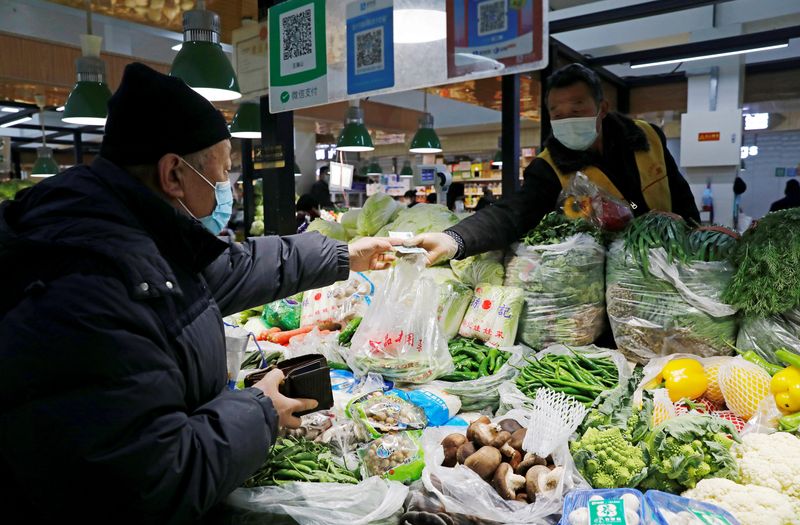BEIJING (Reuters) -China's consumer inflation rose to a 29-month high in September, driven mainly by pork prices, but price pressures remain largely benign in an economy hobbled by strict COVID-19 curbs and a property crisis.
China's central bank has been trying to bolster growth while avoiding aggressive loosening that could fan price pressures and risk outflows, as the Federal Reserve and other central banks raise interest rates to fight soaring inflation.
Consumer prices rose an expected 2.8% from a year earlier, accelerating from 2.5% in August and climbing at the fastest pace since April 2020, data from the National Bureau of Statistics showed on Friday.
Yet underlining weak consumption amid COVID curbs, the core inflation - which excludes volatile food and energy prices - slowed to 0.6% in September from 0.8% in August.
The producer price index (PPI) rose 0.9% year-on-year, easing sharply from a 2.3% rise in August and hitting the weakest since January 2021. Analysts had expected a 1.0% rise.
"Headline CPI inflation (on a year-over-year basis) is likely to stay moderate in the coming months on both a high base and subdued services demand," analysts at Goldman Sachs (NYSE:GS) said in a note.
"We expect year-over-year PPI inflation to continue to fall on both base effects and eased inflationary pressures due to lower commodity prices."
The central bank is likely to focus on spurring the COVID-ravaged economy, although worries over capital flight could limit its policy space, as the yuan has fallen about 11% against the U.S. dollar so far this year.
"The main constraint at the moment is the Renminbi, which is close to its weakest level in over a decade. We don't expect policy rate cuts until pressure on the currency eases," Capital Economics said in a research note.
The central bank will step up its policy support for the economy, its governor, Yi Gang, said in remarks published on Friday.
Food was largely behind last month's inflation pickup, with prices up 8.8% on year after a 6.1% gain in August. Pork prices leapt 36.0% after rising 22.4% the month before and vegetable prices jumped 12.1% after a 6.0% rise in August.
On a month-on-month basis, consumer prices rose 0.3% after a 0.1% fall in August, also supported by a monthly rise in pork prices.
China's economy likely grew 3.4% in July-September from a year earlier, gaining pace from the 0.4% growth in the second quarter, but the expected 2022 growth could still be one of the weakest in almost half of a century, a Reuters poll showed.
"China's inflation situation is quite different from that of Europe and United States, and its monetary policy should be more 'self-oriented', giving priority to boosting domestic demand," said Wen Bin, chief economist at Minsheng Bank.

The central bank is likely to trim the one-year loan prime rate (LPR), the benchmark lending rate, by 5 basis points in the fourth quarter, the poll showed.
The International Monetary Fund on Tuesday cut its 2022 and 2023 economic growth forecasts for China to 3.2% and 4.4%, respectively, saying the frequent lockdowns under the country's zero-COVID policy have taken a toll.